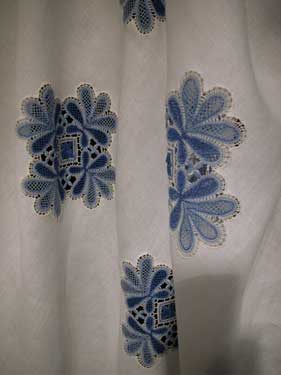

International forum of Rimini (Italy)
In the large room of congress, some sixty towns of Italy were represented. Some foreign countries had also taken part in the exposure. In 1 hour, I could not spoke with everyone because it was still the moment of the installation. The photographs were theoretically prohibited, but I had a special permit of organizing Mrs. Fiorella Gaggi, I thank her. Here thus a small whole show of this exposure. You will notice that there is much text, I translated fanšais of them descriptions history and techic presentations of the stands which I photographed.
It merletto di Cesena
Ispirate Al corali delle miniati LED quattrocento biblioteca malatestinia.
On left: inscrustation of blue flowers for this tablecloth, and, on the right, flowers inspired of liturgical decorations of 1400 with the library of Cesena (realization of Antonia Busi).
 |
 |
| Detail | Detail |
"Cantu" Rosaline lace:
Historical description
"Rosaline" work was born at the end of the 1800's in Belgium where became
widespread. It is a stitch wich drew inspiration from the 18th century Venetian needle
lace : "Venise Ó la rose".
Cant¨ acquired this work and already by the beginning of the 1900's it had a remarkable
production. The lacemaker of Cant¨ are the only depository of the tecnical secrets for
this execution.
Technical description
Lace is made with a very fine wire with several points like the small flowers, the small
sheets, the multiple sheets and the volutes. That gives to the end a very beautiful lace.
The technique is not really difficult, but made up of much of passages which require
attention and which give character to this lace.
The lace of Sansepolcro
Historical description
This type of lace arrived at Sansepolcro at the end of the XIXŔme century with Amalia
Gelli, which had learned with a Belgian sister during a short period from detention in a
prison for women.
The two sisters Adele and Ginna learned with Dalila the principal points from lace in very
little time. They founded the first lace school to the spindles AdŔle and Ginna Marcelli
in 1900. This school became most important of Italy by its prestige and the most
recognized in the whole world.
Domenico Cetri, husband of Ginna impassioned by nature, expressed its talents of
draughtsman by representing forests.
The biennial one of the lace of Sansepolcro, which in is already with its tenth edition,
contributes to reinforce the great tradition of lace in Italy and Europe.
Technical description
To carry out lace, one uses a flat cushion supported on a support with 3 feet and allowing
to make swivel the cushion to 360 degrees according to needs' for work. The number of
spindles varies according to the drawing, but cannot be lower than 4. For more complicated
drawings, one can use to 50 spindles.
Paperboard, pins and hooks are the other instruments allowing the realization. This lace
is characterized by the characteristic from the drawings (generally inspired by the
animals and plants).
 |
 |
Punto Rosaline di Cant¨ Detail |
Page 3/5 |